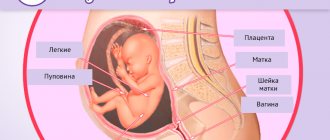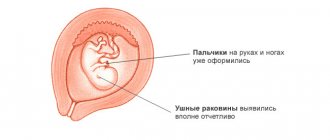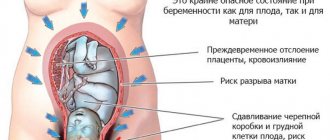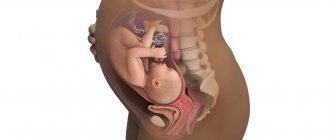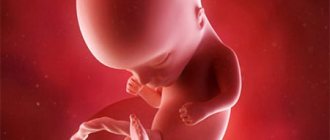Changes that happen to the expectant mother
By this time, a pregnant woman is already getting used to the changes that constantly occur in her body. This period falls on maternity leave, when there is no need to rush to work and you can devote all your free time to yourself and preparing for the upcoming birth. It seems like there is still a long way to go, but that may not be the case.
Readiness for childbirth is determined not only by how the woman feels, but also by whether the fetus meets normal weight standards at 33 weeks of pregnancy. Most likely, by this time she will have already undergone the third screening, which includes the mandatory procedure of undergoing an ultrasound examination. The specialist determines height (it should be between 35-45 cm) and weight (approximately 1700-2000 g) using a table of norms. It is necessary to take into account the personal parameters of the parents; if both of them are not tall or large in body weight, then most likely their baby will also have miniature parameters. Therefore, the issue of compliance or deviation from these standards should be approached on a purely individual basis. Do not forget that even if there is a lag in the weight of the fetus at the 33rd week of pregnancy, then, most likely, closer to the birthday it will gain the necessary grams. The main thing is that the expectant mother remains calm and follows a daily routine and adheres to proper nutrition.
Based on the obtained indicators, you can only get an idea of the approximate weight of the child. Determining these parameters is necessary in order to have an idea at the time of birth regarding the likelihood of the birth of a large fetus, its location, the state of the amniotic fluid and the placenta. This may affect the method of delivery.
As a rule, if a child at 33 weeks of pregnancy weighs less than the established norm, then this is not a reason to panic. In practice, doctors prescribe vitamin therapy, and recommend that the mother take more walks and rest.
What happens to the belly at 33 weeks of pregnancy?
In addition to the fact that a woman will experience pain, she may experience heartburn. By this time it intensifies significantly. There are two reasons: the pressure of the uterus on the stomach and physiological changes in the body that provoke an increase in the acidity of gastric juice.
Another unpleasant sensation that occurs at 33 weeks of pregnancy is shortness of breath. It should decrease as the baby descends a little. Until this happens, you need to reduce your physical activity and look for comfortable positions.
Itching of the skin of the abdomen is another common complaint of expectant mothers. It can be reduced by applying moisturizer to your stomach. It’s good to rub olive or almond oil into your skin immediately after a shower.
By this time, the stomach rises very high, which will cause some discomfort. But there is no need to worry about this, because in the coming weeks it will go down and it will become easier to breathe.
Sometimes a woman is surprised to notice rhythmic twitching of the abdomen. This happens when the baby starts to hiccup. And this happens quite often.
You also need to be especially careful, because the stomach has become heavier and pulls the woman forward. Falls at this time are very dangerous.
What happens in the tummy? Pain in the hands, baby movements and the benefits of omega-3:
External changes in a pregnant woman
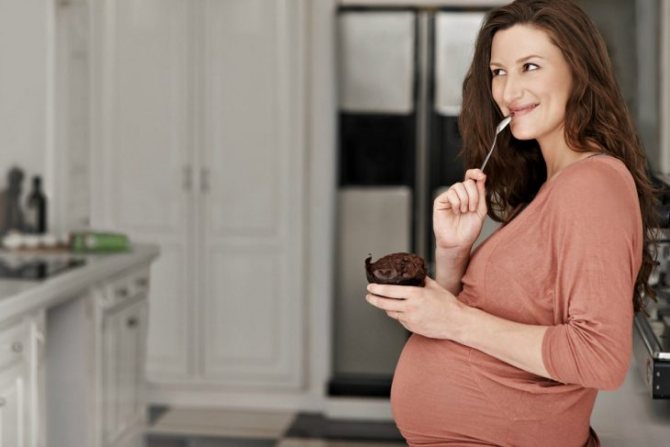
Without an ultrasound, it is impossible to imagine how a child develops inside the mother's womb. Only with the help of this research method can you see with your own eyes what the baby is doing at the moment, how he feels, whether or not there are deviations in the development of internal organs and body parts. But there is one drawback: you cannot resort to this method of observation all the time. Consequently, how pregnancy is progressing can only be judged by how the belly grows at 33 weeks of pregnancy and how much weight the woman has gained. The processes occurring inside the mother’s body are also judged by the results of blood and urine tests, the presence of edema and any complaints about well-being.
At this stage of pregnancy, the expectant mother may notice that the growth of the abdomen has slowed down somewhat. This is due to the fact that the peak of its intensive growth occurs in the second trimester, when changes in its shape and size become noticeable every week. At 32-33 weeks of pregnancy, the belly becomes more rounded, in some pregnant women it becomes more convex, as if there is a ball inside. The external outlines acquire smooth contours, and the position of the baby determines what the upcoming birth will be like. This means that if the baby is positioned head down, the birth will most likely take place naturally, since in the pelvic position (when the baby is head up) a cesarean section is recommended. But even if at this time the child has not yet accepted the correct position, this does not mean at all that he will not change it during the birth process. And this happens in practice, so there is no need to worry in advance.
In addition to the increase in the size of the abdomen, changes also occur in the appearance of a pregnant woman. People around you may notice that not only your tummy is rounded, but also that your facial features become softer in appearance. This is due to the active work of hormones that the mother’s body actively produces. Most women note that their hair has become stronger and their nails break less.
The gait also changes, the movements are no longer so fast. In some cases, women note that the sciatic nerve may become pinched, and then the gait becomes like a duck's. But don’t be shy about it; you can reduce the load if you go slowly. A growing belly makes itself felt more and more; leaning forward or simply sitting down becomes more and more difficult. Therefore, it is extremely important that someone close to you is with the pregnant woman and helps, for example, put on shoes or place a pillow under her back while resting.
Childbirth at 33 weeks
Sometimes it happens that labor begins earlier than planned, and at 33 weeks it will be premature, and the baby will be premature. But by this week, the baby’s body is already sufficiently formed to exist independently; during childbirth, he will be able to cry and his lungs will expand; there may be enough surfactant for independent breathing. Of course, the nervous system is not yet mature enough, and the ability to maintain body temperature is still limited, but other organs and systems are working quite actively. The baby will need special care and constant warmth, and he will be able to grow and develop quite actively. Typically, such babies are placed in the ward of the children's department in cribs with constant temperature maintenance and additional oxygen supply. The sucking reflex of such a baby may be weakened. And most likely he will have to give expressed breast milk until he gets stronger.
How does a pregnant woman feel at this stage?

Visits to the doctor and monitoring of the gestational age occur according to the weeks of the fetus’s gestation. Therefore, it happens that the question of how many months are in the 33rd week of pregnancy may confuse some. In fact, everything is not so difficult, the given period is 8 months and 1 week. Any deviations from normal well-being should alert the expectant mother. The appearance of late signs of toxicosis may lead to the need to go to the hospital for a while. The reason for this measure may also be a deviation from the normal weight of the fetus at the 33rd week of pregnancy. In order to maintain the general well-being of the mother and stimulate the baby’s weight gain, a vitamin complex is prescribed in the form of intravenous injections, as well as drugs to normalize blood supply (for example, Curantil).
The norm is considered to be training contractions, which can begin from the 33rd week. In order to reduce tone and muscle spasms, it is recommended to use “No-Spa”, “Papaverine”. You can take a warm bath; directing the shower stream to the lumbar area helps. If after all the manipulations the cramping attacks have not stopped, it is recommended to consult a doctor.
At this stage, anemia may occur due to low hemoglobin, so it is worth including foods rich in iron in your diet. If the duration of sleep is less than eight hours a day, then circles under the eyes cannot be avoided. To prevent this, it is recommended to interrupt your activity even in the afternoon. The optimal sleeping position on the side is becoming familiar to most pregnant women. This is an important point, since the enlarged uterus when lying on your back can lead to compression of the vena cava. The woman may feel that the baby is beginning to move actively, which in this case is a sign of insufficient oxygen supply.
It is worth paying attention to the discharge; if there are streaks of blood in it, a lot of mucus, then, most likely, the mucus plug begins to come off. This symptom is not typical for this time, so it is recommended to consult a doctor.
Indications and contraindications
The third ultrasound is scheduled at –34 weeks of pregnancy. The optimal timing of the procedure is determined by the doctor.
Some women refuse to undergo the latest ultrasound, considering this procedure unsafe. It is important to understand that this examination largely determines how successful the birth will be.
Ultrasound at 33 weeks of pregnancy is considered absolutely safe. This examination does not involve irradiation of the mother and child. The image is displayed on the screen due to the reflection of ultrasonic waves from tissues of different densities. There are no contraindications for this study.
Ultrasound diagnostics at the 33rd week is prescribed not only as a routine examination. There are a number of indications for ultrasound:
- multiple pregnancy;
- in vitro fertilization;
- women who have had a cesarean section or uterine surgery;
- presence of complaints (stopping or increasing fetal movements, discomfort in the abdominal area, pressure surges);
- suspicion of intrauterine growth retardation;
- carrying an Rh-positive child by an Rh-negative mother;
- suspicion of abnormal position of the fetus inside the womb.
To watch a video review of the 33rd week from a consultant doctor:
How is the baby feeling?
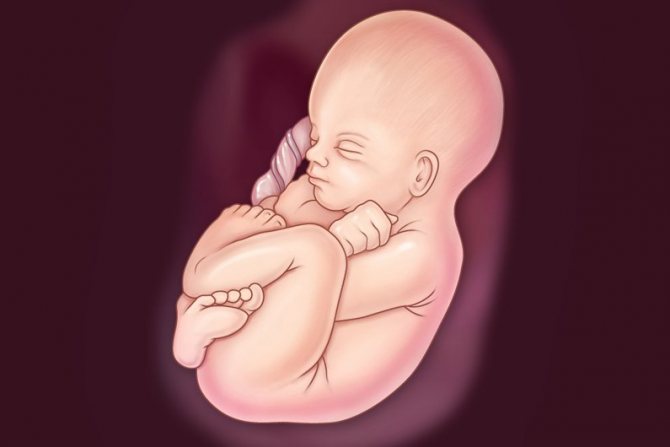
There is less and less free space left inside the placenta for the baby to actively move. The mother may note that fetal movements at 33 weeks of pregnancy become more coordinated. At this stage, the child’s internal organs continue to form. In particular, subcutaneous fatty tissue is formed, an iron reserve is formed in the liver, the endocrine system completes stages of development, the walls of blood vessels thicken, and the heart increases in size. The child is actively interested in what is happening outside. It can react to loud sound, bright light.
One of the important indicators of health is the formation of one’s own immunity. While the baby is in the womb, he is protected by the mother's body, but as soon as he is born, he will need his own protective resource that will protect him from harmful microorganisms.
If at the 33rd week of pregnancy the normal weight of the fetus is determined by ultrasound, then this study determines the degree of maturity of the lungs. This indicator is important because in the event of emergency development of labor it determines the survival of the fetus. It is worth noting that, along with data on lung development, liver echogenicity indicators are compared. Normally, they should coincide and be equally developed.
Why does my stomach hurt at 33 weeks of pregnancy?
By this time, the embryo increases in size.
For some women, the baby is excessively large. For example, it increases above 3.5 kg. Pressure is generated on the following organs:
- kidneys, bladder;
- liver, intestines, stomach;
- lungs.
The location of the organs changes, but this happens normally. The state cannot be changed. The patient can periodically stand in the knee-elbow position, improving the condition of the internal organs. The fetus is actively moving, there is not enough space for it. When he turns over, the patient feels acute pain. As the baby develops, the kicks become stronger.
The enlarged uterus puts pressure on the vessels, creating a load on the portal vein and aorta, and the patient’s condition worsens.
It is difficult for her to move and she has severe, nagging pain in her lower abdomen. When lying down, spots appear before the eyes and fainting. When blood circulation is difficult, numbness in the legs and arms occurs.
If the musculoskeletal system is weak, a load is created on the back, lower back, and hip joints. The characteristic pain syndrome is localized in these areas. To eliminate the condition, do not use medications. It is enough to wear comfortable clothes and attend massage sessions.
After 32-33 weeks, false contractions appear. These are involuntary contractions of the uterus that prepare the body for the upcoming birth. They are different from real contractions that trigger labor.
Determination of fetal development parameters by ultrasound
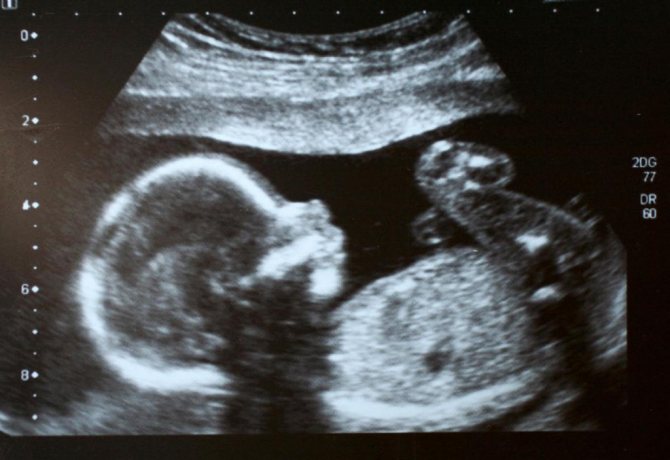
An ultrasound examination is necessary not only to determine height and weight, but also to understand what is happening to the baby at 33 weeks of pregnancy. All sizes from head to legs are determined visually on the screen. These parameters make it possible to determine the correspondence of fetal development to the established gestational age. In particular, the following values are measured (the norms will be indicated in brackets):
- Circumference of the head (289-333 mm) and abdomen (267-325 mm).
- Biparietal size (77-91 mm).
- Fronto-occipital size (98-116 mm).
- Nasal bone (8.9-13.9 mm).
- Coccyx-parietal size (at 33 weeks of pregnancy, the size of the fetus is about 30 cm).
- The length of the bones to be measured is: humerus (53-63 mm), forearm (46-54 mm), thigh (58-68 mm), lower leg (54-62 mm).
It is worth considering that during multiple pregnancies, the size and weight of the babies may differ from the given norms. Therefore, you should not expect that at 32-33 weeks of pregnancy they will fit the generally accepted standards. As a rule, by the time of birth, the weight of one baby can be no more than 2500 g, and the second is only 200-300 g heavier than the first.
The normal weight of the fetus at the 33rd week of pregnancy also depends on the lifestyle of the expectant mother, heredity and the presence of pathologies. If polyhydramnios is established, the child may weigh less than expected. This also confirms the likelihood of developing a congenital disease. It is for this reason that it is important to monitor the well-being and changes that occur in the child’s body throughout the entire period of pregnancy.
Feelings of a woman at 33 weeks of pregnancy: familiar and new
You should not expect that a woman’s physical and emotional sensations will somehow change dramatically after the “last turn before the finish line.” As the joyful event of the long-awaited meeting with the newborn approaches, the woman experiences more and more the burdens associated with 9 months of gestation. This can be roughly expressed alternately:
- morning “I can’t feel this pain in my back anymore, just to give birth as soon as possible!”
- lunchtime “What a joy it is to feel his movements inside!”
- for afternoon tea: “Oh, how my legs hurt! Where should we put them higher?”
- evening “Oh, how I want to eat more!” And when will this eternal restriction end!
- nightly “Why didn’t they come up with a special sleeping position for pregnant women or special beds so that you could fall asleep!”
If the pregnancy is progressing well, by the 33rd week, signs of toxicosis should no longer bother the pregnant woman (we will talk about a dangerous deviation from this norm - gestosis - below). However, it is unlikely that you will be able to relax, because they will be replaced by other not-so-comfortable sensations. Namely:
- Increasing pain in the back and legs due to significant weight gain (by week 33, acceptable weight gain is 8 -12.5 kg). Back pain can also be painful at night, due to the pressure of a greatly grown fetus. Avoid sleeping on your back and left side (so as not to put stress on your heart). Instead, train yourself to sleep on your right side, with extra pillows under your left leg, left arm, and back. During the day, rest from time to time by placing your legs slightly higher than your body.
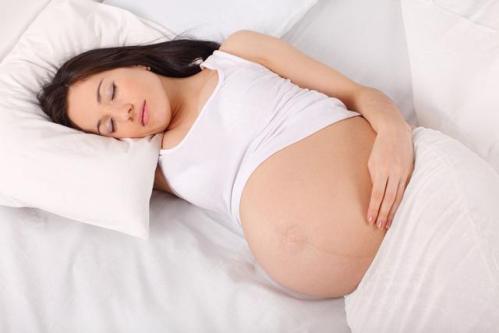
- Increased sweating, shortness of breath, sometimes dizziness, a feeling of lack of air, even loss of consciousness - all this can be experienced by a woman, especially after 33 weeks, especially if there are disorders of the vegetative-vascular system.
The author of the article is a mother of five children. Although almost all of my pregnancies went relatively well and I led an active lifestyle, at the end of almost every one I felt as if I was running out of air. Two or three times I almost lost consciousness in a closed and stuffy room, since I gave birth to four children in the hot summer.
The described sensations are quite understandable, since after the 33rd week a woman literally lives as if for two, and it is quite possible that her own organs are sometimes unable to cope with the increased load. The main thing for every pregnant woman is to know and understand her individual characteristics, and not put herself in risky situations. For example, in my position, I tried to avoid stuffy rooms, excessively tight and tight clothes.
- The already noted changes in the endocrine system are the reason that, as throughout pregnancy, and after 33 weeks, a woman feels that she is hotter than those around her. From my own experience I will say that this is a great blessing in winter, but a real punishment in the heat of summer. Relatives and friends should pay attention to this and be patient and understanding, because even for a second they do not experience all the discomfort that a pregnant woman has to endure. Therefore, if a pregnant woman next to you in the office asks to turn on the central air conditioning, and it is freezing outside and you are already cold, try to make a concession, even if you have to wear outerwear. Your suffering for a few hours is nothing compared to what the expectant mother has to endure for 9 months and 24 hours a day.
- The main symptom by which any pregnant woman can independently determine that the 33rd week has arrived is the cessation of the baby’s “somersaults”. If until now he was like an astronaut in free flight in zero gravity, he could easily turn over in any direction, then having reached a weight of 2 kilograms, now he will not be able to do this - he simply does not have enough space even in his greatly expanded stomach.
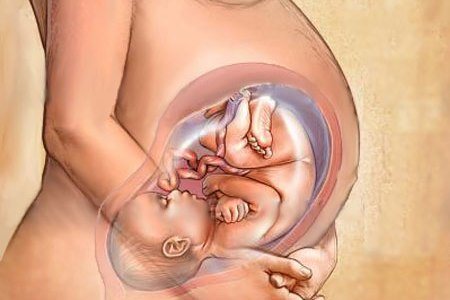
It is ideal if the baby stays in a cephalic presentation position - that is, upside down, since from this moment he will maintain it until the moment of birth. With a breech presentation, a natural birth (that is, not a caesarean section) is also possible if the doctor considers that you are capable of handling the task, since obstetricians know how to deliver newborns in this case too. The absolute indication for caesarean section is the transverse position of the child, which still does not happen very often.
- Instead of funny “coups”, you can now expect quite noticeable “beatings”. Of course, the intensity and force of blows to the walls of the abdomen by its temporary resident depends on the gender, size and individual temperament of the baby. And yet, at least a few times, almost every expectant mother will have to almost gasp from a real blow - a kick “in the ribs”. In a normal cephalic presentation, the baby's legs are located just under the ribs: if you wish, you will soon be able to almost always easily feel his heel, from which it will seem to “float away”. If for some reason your baby has chosen a breech position and remains in it, then you will experience no less uncomfortable sensations from his “peruet”, but in the pelvic area.
They usually give an average figure for the baby’s perceptible movements - 10 vibrations per hour (in some sources, 2 hours), but from my own experience I will say that there is no common denominator for all cases, since it depends on the individual character of the child. The main thing is that the movements exist and retain their original character. Sometimes during the day you may simply not notice them - don’t panic right away: in the evening before bed, try to communicate with your baby, stroke your belly, talk. Most likely, you will be answered with one or two blows from “inner space.” If within 24 hours you absolutely have not felt a single movement, especially if until now they have been very pronounced and active, it is better to play it safe and go to the doctor, even if 2 days ago you had a scheduled consultation.
- Another characteristic symptom of the 33rd week and subsequent ones can be called vivid, sometimes disturbing, almost always thematic dreams. Often it is during this period that women have real prophetic dreams, which are known even from the history of religions. It happens that her previously deceased relatives “come” to the expectant mother: grandfathers, grandmothers, and even give a name to the unborn child or foretell the exact date of birth. This is completely normal for a pregnant woman; you should not be afraid of it or attach too much importance to it. The most important thing for you is to maintain your health and that of your baby.
- A much less attractive symptom of the 8th obstetric month is insomnia. Personally, it felt like I hadn't slept at all in recent months. This is all the more unpleasant because with the birth of a baby, only in exceptional cases does a young mother manage to get enough sleep. She often expects at least another 3 months of sleepless nights due to the baby’s colic. Therefore, if after 33 weeks you cannot get enough sleep at night, try to find time during the day in order to “get” the necessary hours. Avoid fatigue, let alone wear and tear of the body at the end of pregnancy. You only dream that this is the end of your hardships. The real challenges are yet to come; they will begin immediately after returning home from the maternity hospital, and will never end as long as your baby remains a child. Over time, you will get used to them and will no longer be able to live differently. But it will be difficult at the very beginning. Therefore, just at the end of pregnancy, when sleeping is difficult, uncomfortable and almost impossible, you just need to get enough sleep - in order to stock up on strength for the difficult first months ahead.
Video - 33 weeks of pregnancy
What to pay attention to
Of the listed sensations of the expectant mother, almost all are absolutely normal for the period described, that is, it is simply useful to know about them, but you should not attach much importance. Only a sudden complete cessation of the baby’s movements should be a valid reason for an emergency visit to the doctor. However, there are symptoms that are much more important, the presence of which may indicate the need for urgent medical attention. Therefore, they are given a special section in our article.
Movements and their intensity

The force of the blows becomes more noticeable than before. This is due to the fact that the child is gaining muscle mass. The volume of amniotic fluid decreases slightly. The fetus spends more and more time sleeping, and the woman can clearly distinguish its activity mode and rest periods. At 33 weeks of pregnancy, the baby can see his first dreams. This is caused by the fact that connections between neurons begin to appear in the fetal brain.
Doctors recommend monitoring the intensity of movements; the norm should be at least 10 times in two hours. It is necessary to take into account even the slightest movements of the baby. Excessively frequent and active movements may also indicate a lack of oxygen. Therefore, it is worth regularly ventilating the room in which the pregnant woman is located, and being in the fresh air for at least 3-4 hours a day.
Discharge
At 33 weeks, the discharge should be light, transparent or slightly whitish, without a strong odor or pathological inclusions. Due to the mucus plug, the discharge may be a little more normal than usual. At this time, the nature of the discharge may change with the development of thrush. In this case, the discharge becomes milky white, cheesy or flaky, with the smell of sour milk, abundant, with the development of itching and burning in the vagina.
This condition requires treatment to avoid premature birth or intrauterine infection of the fetus and poor health of the mother. The doctor will prescribe treatment with suppositories; it is necessary to observe the rules of hygiene and wear only breathable underwear, wash with herbal decoctions or soda solution. No less dangerous can be greenish, yellow, gray or white discharge mixed with mucus, foam, bubbles, pus or a strong unpleasant odor. Such discharge is usually accompanied by redness of the perineum, itching and burning sensation in the vagina.
Typically, this is how genital infections manifest themselves, which must be treated immediately in order to avoid intrauterine infection of the fetus. Usually the doctor performs a smear and, based on its results, prescribes local, and very rarely, general therapy with oral medications. Bloody, spotting discharge or blood on underwear is dangerous. This condition requires hospitalization and the exclusion of pathologies of the placenta and cervix, and premature birth.
If the discharge is abundant, watery, with a sweetish odor, without color and constantly wets the laundry, it is necessary to exclude leakage of amniotic fluid. If there are defects in the amniotic sac, the odes leak and open the way for infection of the fetus. In addition, this is a real threat of the onset of labor. It is necessary to conduct a test for amniotic fluid at home or at a doctor's appointment. If water leaks, you need to immediately decide on continuing the pregnancy - the infection can penetrate to the fetus in just a few hours.
Strange tremors, or How to understand that a child is hiccupping
Similar to movements, but more regular and longer in duration - this is all about the first signs of hiccups in a child. It cannot be confused with the normal movements of a child. If it is located correctly in the womb, we are talking about the cephalic presentation of the fetus during pregnancy at 33 weeks, then rhythmic tremors will be felt in the lower abdomen. The movement of the legs will be felt in the ribs, in the upper abdomen. With the pelvic position of the fetus, everything will be exactly the opposite. Accordingly, with a transverse position, the head will be on the side, from where the mother will feel the corresponding shocks.
There is no clear criterion regarding the frequency of cases of hiccups in a child during the day. Some pregnant women noted this phenomenon throughout the day: morning, afternoon and evening. Others, on the contrary, once every few days. There are several versions about why this happens, for example, some believe that in this way the baby’s body prepares for birth by training the lungs. According to another version, he swallows amniotic fluid, which causes contractions of the diaphragm. Therefore, if at 33 weeks of pregnancy a child hiccups, then this is more the norm than a deviation.
In any case, do not immediately panic. A sign of hypoxia (lack of oxygen) is a decrease in hemoglobin and lack of fetal movement. In other cases, it is necessary to adhere to the correct sleep and rest regime.
Discharge at 33 weeks of pregnancy
Do not stop monitoring any changes in discharge at 33 weeks of pregnancy. At this time, their character remains the same: the discharge is normally moderate, homogeneous, light or light milky in color, with a slight smell of sour milk. The appearance of green, yellow, purulent discharge, curdled discharge or mixed with flakes is a sign indicating the development of an infectious disease of the genital tract. For a genital infection, the discharge often changes not only the color, but also the smell - it begins to smell sharp and unpleasant. In addition, a noticeable inflammatory process cannot be ruled out, causing significant discomfort: burning and itching, swelling of the genital organs. It is necessary to diagnose the pathogen and resort to adequate treatment in case of infection, otherwise there is a high risk of intrauterine infection of the fetus. An extremely negative symptom is the appearance of spotting at 33 weeks. The appearance of blood is usually associated with placenta previa or placental abruption, both conditions pose a high risk for the further development of the fetus and the normal course of pregnancy. Therefore, even with a slight separation of blood, in the presence of spotting brown discharge, regardless of whether there is pain in the abdomen or not, you should immediately call an ambulance. You should also seek medical attention if thin, watery discharge occurs. A larger than usual amount of discharge, and even liquid discharge, may indicate leakage of amniotic fluid. Remember that damage to the membranes, which is associated with the release of amniotic fluid, is not always accompanied by a one-time and simultaneous outpouring of amniotic fluid. Thus, amniotic fluid can leak in small portions; women who have encountered this phenomenon talk about a constantly haunting feeling of increased humidity in the perineal area. Even at the slightest sign of leakage, you should contact your doctor as soon as possible: if the membranes rupture, the infection can penetrate to the fetus within the first 24 hours.
Fetal position norms
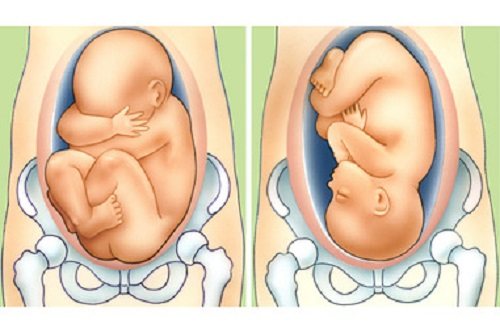
The main questions that concern not only parents, but also the doctor: what happens to the baby at 33 weeks of pregnancy, how does he feel, what position is he in the uterine cavity? It is believed that with a premature birth at this stage, the baby is born quite viable. One of the important parameters that are determined at this stage of pregnancy is the position of the fetus in the womb. The most unfavorable option is a transverse arrangement. It is an absolute indication for delivery by cesarean section. The least successful option, but likely for natural delivery, is the pelvic position of the fetus. However, this also has its own characteristics, which are determined closer to the expected date of birth.
It is believed that the main part of the difficult journey has been completed, the calendar shows the 33rd week of pregnancy, how many months are already behind us, we can safely say that this is the home stretch. Therefore, it is necessary to accept the fact of the location of the fetus and not worry if obstetric care is carried out through surgery.
Different fetal positions may occur in multiple pregnancies. In this case, it is almost likely that one of the babies will be positioned correctly, the other will not. Therefore, doctors pay special attention to the development of the fetus at 33 weeks of pregnancy and until the birth itself. Because with multiple pregnancies, the risk of labor occurring earlier than expected is quite high. In order to maintain and monitor the course of a multiple pregnancy for as long as possible, doctors recommend that a woman go to the maternity hospital in advance.
Changes in the body of the expectant mother at 33 weeks of pregnancy
What happens to the mother at 33 weeks of pregnancy? If the expectant mother experienced a decrease in hemoglobin levels, then by this time everything should return to normal. At the 33rd week of pregnancy, the belly continues to grow more and more, which creates discomfort and pain in the chest and pelvis. You can already clearly feel the kicks of your unborn baby.
The average weight gain at 33 weeks of pregnancy is from 9 to 12 kg, from the navel the uterus is approximately 13 cm high.
Due to the enlarged uterus, pressure occurs on the bladder, which provokes a frequent urge to urinate. A woman can go to the toilet on average up to 6 times per night.
Light tremors in the abdomen are caused by your baby's hiccups. The amount of amniotic fluid continues to grow and is now 1 liter.
To reduce lower back pain at 33 weeks of pregnancy, it is recommended to perform circular rotations of the pelvis in both directions alternately. After completing a set of exercises, you need to lie down and rest. In addition to lower back pain, a woman may also experience leg pain and swelling. Cool compresses on the legs or a cushion under the ankles while sleeping will help alleviate this condition.
For pain in the pelvic area, it is very useful to swim in the pool and wear a special bandage.
It should also be noted that it is at the 33rd week of pregnancy that a woman may notice that contractions become frequent, but they should not be confused with real prenatal contractions.
Also, the following unpleasant changes may occur in the expectant mother’s body, which should be reported to your doctor immediately:
- spotting, which may indicate placental abruption. If watery discharge appears, this may be a sign of leaking amniotic fluid. Abundant discharge of water is a harbinger of premature birth;
- the passage of a mucus plug can also be a sign of premature labor. It is necessary to stop having sexual activity to avoid the penetration of various infections;
- discharge of leucorrhoea (can be of various characters: curdled, in the form of flakes, lumps, foam, yellow, green, gray) is a pathological condition. It is necessary to immediately consult a doctor and take smears for microflora. Leucorrhoea can be caused by the presence of an STI infection or;
- discharge of the first colostrum from the breast. This is also associated with early birth;
- pain in the lower abdomen, which may be associated with an infection in the genitourinary tract. The pain may be accompanied by severe itching and discomfort when urinating. A woman may have an increase in temperature, level of leukocytes and ESR in the blood;
- inflammation of hemorrhoids.
Belly photo. What does the belly look like at 33 weeks pregnant?
Breech presentation
When the baby does not have time to turn head down and take the most optimal position for his birth, doctors talk about breech presentation. At the 33rd week of pregnancy, it is likely that the baby will no longer be able to change position and by the time labor begins, the question will arise about how it will be born. Thanks to modern technologies, it is possible to control this issue before the onset of intense contractions. Doctors try to offer the most favorable option for preserving the health of the mother and fetus, as a rule, this is a cesarean section.
Women who are faced with this situation often wonder: what happens at 33 weeks of pregnancy with a child who is in a breech position? You definitely don’t have to worry about it harming your baby. If other indicators are normal, then until the birth itself you must adhere to the doctor’s recommendations. In medical practice, it is customary to distinguish the following types of presentations:
- Gluteal leg syndrome, which is diagnosed in 25% of cases in pregnant women, in which the position of the fetal legs is crossed, knees and hips are bent.
- The gluteal region is considered the most favorable for the possibility of natural childbirth. This diagnosis is made in 65% of cases of breech presentation of the fetus. The position of the baby is visualized by ultrasound as follows: sitting on the bottom, knees straightened, legs pressed to the body and bent at the hips.
- The foot position occurs in 10% of cases. It looks like this: one or two legs of the fetus are extended at the hip.
However, there is a small percentage of probability that the mother will be able to “agree” with the baby and he will still take the correct position. Some doctors recommend standing on all fours, thereby stimulating the baby to move. By the way, this exercise perfectly relaxes the back muscles. Therefore, we can safely say that it is useful for both.
When figuring out the reason that leads to such an arrangement of the fetus, it is worth noting that there may be other factors:
- Premature onset of labor (it is believed that before 36 weeks there is a possibility that the baby will change its position).
- Polyhydramnios or oligohydramnios (this leads to excessive activity of the fetus inside the womb or, conversely, the inability to take the correct position due to lack of space).
- The presence of defects or deviations in the development of the child.
- Weak muscles of the uterine body, which occurs during short breaks between the previous and current pregnancy.
- Pathologies in the development of the uterus, abnormal structure, the presence of fibroids.
Tests and ultrasound results at 33 weeks of pregnancy
A planned visit to the gynecologist at 33 weeks of pregnancy includes:
- Abdominal circumference measurements are required.
- Weighing the expectant mother.
- Listening to the baby's heartbeat.
- Issuing referrals for ultrasound, blood and urine tests.
During a routine ultrasound visit, the doctor determines the following mandatory factors:
- position of the fetus and the umbilical cord (no umbilical cord entwined around the baby’s neck);
- is there any inhibition in the child’s development, are the organs characteristic of the 33rd week of pregnancy formed? The child’s lungs lend themselves to very careful study;
- establish the approximate amount of amniotic fluid to diagnose the occurrence of low or polyhydramnios;
- study the condition of the placenta, whether it has succumbed to aging and whether it corresponds to the period - 33 weeks of pregnancy;
- mandatory setting of the number of heartbeats of the unborn child;
- if the gender of the child could not be determined at previous ultrasound visits, this can be done now. An ultrasound performed at a later stage will not give an answer due to the large size of the unborn child and his low mobility.
Using an ultrasound, the expected date of birth is again calculated according to fetal development indicators.
Ultrasound photo at 33 weeks of pregnancy
What does umbilical cord entanglement lead to?
During the third screening, not only the condition of the fetus is determined, but also the functioning of the uteroplacental circulation. In some cases, an umbilical cord entanglement is established. At 33 weeks of pregnancy, this may indicate that immediately after the birth of the child, the doctor will urgently need to remove the umbilical loop from his neck. The possibility of entanglement is influenced not so much by the child’s mobility as by the length of the umbilical cord. It is believed that the longer it is (for example, more than 70 cm), the higher the risk of loops forming around the baby’s neck. There have been cases when the umbilical cord wrapped around the fetal body, reducing its motor activity.
Monitoring of blood flow inside the umbilical cord is carried out using Doppler ultrasound and during CTG. These studies make it possible to determine what happens to the child at 33 weeks of pregnancy and how he feels. Since, while inside the womb, the baby does not breathe on his own, the presence of a single or more entanglement does not pose a certain threat to the health of the fetus. You should only be concerned when the blood supply is disrupted and the child begins to experience signs of hypoxia. The picture can be corrected with the help of properly prescribed treatment. This can be done by the doctor who is caring for the pregnancy.
It feels like at 33 weeks of pregnancy, a woman may not notice that her baby has an umbilical cord entwined. This moment does not manifest itself in any way until the onset of childbirth. However, the doctor delivering the baby must be aware of this circumstance. As a rule, he finds out about this by studying the results of the ultrasound, which are available in the medical record.
EX at 33 weeks of pregnancy. Severe gestosis
Girls, I want to share my experience of pregnancy with gestosis. (also, see my diary).
On September 26 (Thursday) I was again taken from the residential complex to RD 10 with high blood pressure 150/100, protein 0.3 g/l in the urine. The rest of the maternity hospitals were closed or overcrowded. I thought I’d lie down for a week and go home with a signature. Ultrasound and CTG are good, everything is normal.
In a week, i.e. on Thursday, October 3, the protein rose to 2 g/l, the pressure rose more often than before. Also, the day before I went with Holter for 24-hour blood pressure monitoring; at night I had episodes of hypertension, but during the day I was normal.
CTG indicators worsened, fetal ultrasound revealed blood flow disturbances of the 1st degree. In the afternoon I was called in for an examination with the head physician, the head of the pregnancy pathology department, my attending physician and the deputy. chief physician This deputy The chief doctor, “Mr.” Yuri Anatolyevich Bogatyrev, began yelling at me that I had preeclampsia and needed to have a caesarean section. I didn't know that obstetricians and gynecologists could be such sadists. Can you imagine the hysteria that happened to me? What kind of caesarean if I am 33 weeks pregnant? She said that I was writing a refusal from the CS and leaving the maternity hospital.
It was a hellish night, I was thinking about this whole situation, asking the whole world, why is this hell happening to me? I ran throughout my entire pregnancy, everything was fine from the fetal side... My husband said that tomorrow he would pick me up and take me to another maternity hospital.
The next morning, I passed urine in the morning, washed myself completely and was ready to leave under signature. The doctors came again, white 1.2, measured the pressure - 150/90. My doctor (thank her very much for her sensitive attitude and care) said that they would transfer me to the intensive care unit to “drip” until the evening. Hysterical, I was again taken on a gurney to the ICU. I definitely didn’t intend to give birth in this maternity hospital, much less have a CS at this time. I wrote refusals from the CS.
The head physician agreed with the head physician of Maternity Hospital 4 to transfer me to them, because... The equipment there is much better and there is everything to take in a premature baby.
My family, my husband, his relatives - everyone was on edge. My husband was afraid of losing both me and the child. In the evening I was transported by ambulance to maternity hospital No. 4, my condition worsened. In the emergency department they did an ultrasound - oligohydramnios, disorder of feto-placental blood flow grade 2b, placental maturity 1-2. My blood pressure rose again to 160/100. Moreover, my health did not suffer, I felt like a very healthy woman and did not even feel when my blood pressure was low or high.
The doctor receiving me said that they were waiting for me for half a day to do an ECS, a team of neonatologists was ready and a place for the child…. I could no longer cry; I was probably still injected with sedatives intravenously. It seemed to me that the whole world was against me, that the doctors were in cahoots. I now understand that I assessed the situation inadequately. While my blood pressure was being lowered, 3 or 4 doctors came to see me, because... I wanted to write a refusal again. They explained to me in detail that my condition was serious, that the child had already begun to suffer in utero and in the coming hours all this would end sadly - first I would lose the child, and then I would begin to have multiple organ disorders, from which it would be difficult to get me out. The doctors' arguments were convincing and I signed all the documents for the ECS.
I called my mother and husband, warned them, and they took me to the operating room. I was given a Caesarean section under spinal anesthesia.
At 22:19 my daughter was born, tears flowed when I saw her and heard her cry. Weight 1750, height 43 cm, Apgar score 7/7. Naturally, she was taken to the neonatal intensive care unit, and after suturing, I was taken to intensive care. The next morning, most of the swelling had gone away, my blood pressure had returned to normal, and there was no longer any protein in my urine. Preeclampsia cannot be treated; it goes away after delivery.
I am grateful to all the doctors who saved both me and my baby. The next morning we were transferred to the postpartum ward and at 12:00 I came to the neonatal PICU to look at my husband and I’s masterpiece. The daughter turned out to be a copy of her dad. Daddy's girl 200%. She lay in an incubator with nasal cannulas pumping oxygen under pressure to help her breathe easier. They fed her through a tube. From the second day she began to suck the pacifier on her own and I went to feed every 3 hours. Also, the cannulas were removed and a cap was installed with O2 supplied to it. On the 3rd day, October 7, she was transferred to City Clinical Hospital No. 13, and I was discharged on the 4th day with a signature. The tests were good, but after severe gestosis they are discharged for 5-6 days. I couldn’t wait, I missed my child, and I left with a signature. And today I visited her in the hospital, took tests so that later I could be with my daughter, and took her expressed milk.
The whole family is praying for her health, I have prepared myself that there is a lot of work, care and care ahead so that my “bunny” grows up to be a strong girl.
After everything that happened to me, I am no longer afraid of anything. And I leave the most difficult and terrible things behind. There is a future ahead that we make ourselves. And I sincerely believe that the experience of neonatologists will help us overcome all the difficulties in caring for a premature daughter.
What to do at 33 weeks pregnant? — Video guide
A big wash awaits you! Wash clothes and bedding purchased for your unborn child, as his skin is incredibly sensitive and will not tolerate the slightest irritation in the fabric. To do this, choose the most gentle detergents specifically designed for babies with hypoallergenic or sensitive skin.
Every expectant mother eagerly awaits the moment when she can feel the baby move. This is not surprising: after all, internal impulses contribute to the perception of the child as a full-fledged person, and not just pictures on the screen.
But tracking movements is important not only for your own joy, but also for drawing conclusions regarding the progress of pregnancy. For example, it is known that mothers expecting their first child give birth 20 weeks after the initial push. And those women who already have children can expect a new addition to the family in 22-23 weeks.
Reasons for caesarean section at 33 weeks of pregnancy
- Lack of vitamin D in a woman’s body, which can cause rickets in the unborn child.
- Insufficient amount of calcium, leading to the development of hemorrhoids and varicose veins (due to fragility of the vessel walls).
- Large weight gain during pregnancy, which can lead to diabetes in the future.
This week, your baby weighs just over 1.8 kg and is over 42.5 cm tall. He no longer looks much like a wrinkled alien, and his skeleton is only getting stronger every day. It is noteworthy that the bones of the small skull are not a monolithic structure, so to speak; that is, they can move and overlap. This is why it is easier for the baby to pass through the birth canal at birth. By the way, the pressure on the head during childbirth is so intense that many children are born with a cone-shaped skull. During infancy and early childhood, the bones of the skull continue to grow, as do the brain and other tissues.


